Is bioenergy ever truly green? It depends on five key questions
Plans to revive an old coal-fired power station using bioenergy are being considered in the Hunter region of New South Wales. Similar plans for the station have previously not gone ahead. As we grapple with decarbonization, ...
May 1, 2024
0
24


